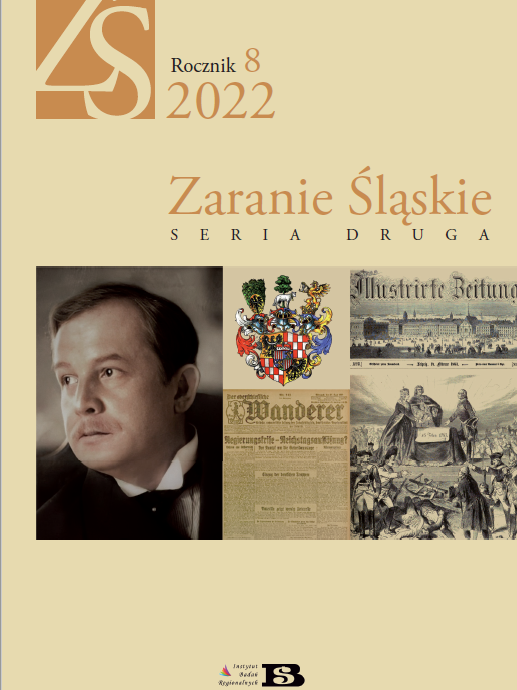The House of Schaffgotsch between Austria and Prussia during the Silesian Wars 1740-1763)
Keywords:
Treaty of Breslau and Berlin of 1742, Silesian Wars of the 18th century, the Schaffgotsch family, Austria, PrussiaAbstract
280 years ago, in 1742, the First Silesian War came to an end. The treaty of Breslau and Berlin resulted in the division of Silesia between Prussia and Austria, both of which happened to fight for this region twice again in the years to come - during the Second Silesian War of 1744-1745 and the Seven-Year War of 1756-1763. However, these two conflicts only confirmed the original division. Throughout the conflict, both sides fought with changing fortunes. The Silesian aristocrats were compelled to choose sides and bear the consequences of their choices, which ranged from being showered with privileges to being imprisoned, from being exiled to being allowed to carry on with their lives and keep their demesne. One of the most important and influential aristocratic families were the Schaffgotsches. Count Johann Anton and his sons experienced all the above mentioned circumstances. The count first fled before the Prussian army, only to return some time later. His son, Prince-Bishop of Breslau, Philipp Gotthard, was first honoured with the highest Prussian military award, the Order of the Black Eagle, but afterwards - exiled from the Prussian part of Silesia. An Austrian rittmeister, Johann Nepomuk, died as a Prussian chamberlain at the royal court in Berlin. Karl Gotthard, having sworn an oath to Prussia, died in the Habsburg ruled Prague. Emmanuel Gotthard died, as a subject of the Prussian emperor, in the last days of the Seven-Year War. The border established in the peace treaty of 1742 is still in existence and today - with some minor differences within the Teschen Silesia - constitutes the state border between the Republic of Poland and the Czech Republic
Downloads
References
Akta majątku Schaffgotschów w Cieplicach, pow. jeleniogórski (153/0), Archiwum Państwowe we Wrocławiu, Wrocław.
Reichs-Post-Reuter (103) [Nota]. (1773, 29 czerwca).
Allgemeine Deutsche Biographie (T. 30). (1890). Verlag von Duncker i Humboldt.
Allgemeine Deutsche Biographie (T. 36). (1893). Verlag von Duncker i Humboldt.
Bergmann, J. G. (1830). Beschreibung und Geschichte von Warmbrunn und seinem Heil-Quellen. Landolt.
Bergmann, J. G. (1832). Beschreibung und Geschichte alten Burgreste Greiffenstein, Samuel Luge.
Biographisches Lexikon des Kaiserthums Österreich (T. 29). (1875). K. K. Hof- und Staatsdruckerei.
Blaźek, C. (1885). J. Siebmacher’s grosses und allgemeines Wappenbuch: T. 4(11) Der Adel von Österreichisch Schlesien. Verlag von Bauer und Raspe.
Conrads, N. (2006). Książęta i stany. Historia Śląska 1469–1740. Oficyna Wydawnicza ATUT – Wrocławskie Wydawnictwo Oświatowe.
Czapliński, M., Kaszuba, E., Wąs, G., Żerlik, R. (2002). Historia Śląska, Wydawnictwo Uniwersytetu Wrocławskiego
Das Breslau-Lexikon (T. 2). (1994). Lauman – Verlag Dulmen.
Das Haus Österreich und der Orden vom Goldenen Vlies. (2007). Leopold Stocker Verlag.
Davies, N., Moorhouse, R. (2002). Mikrokosmos. Portret miasta środkowoeuropejskiego. Vratislavia Breslau Wrocław. Znak.
Des Neuen Genealogischen Reichs- und Staats- Hand- Buch zweiter Theil. (1777). Varrentrapp und Wenner.
Des Neuen Genealogischen Reichs- und Staats- Hand-Buch zweiter Theil. (1775). Varrentrapp und Wenner.
Die Ritter des Königlich Preußischen Hohen Ordens von Schwarzen Adler und ihre Wappen (1701–1901). (1901). W. Moeser Verlag.
Franke, A. (2001). Zamki, pałace, dwory w Kotlinie Jeleniogórskiej. Przegląd. W: Dolina zamków i ogrodów. Kotlina Jeleniogórska – wspólne dziedzictwo (Materiały pokonferencyjne). Muzeum Okręgowe w Jeleniej Górze.
Gleditschen, J. F. (Red.). (1745). Jährliches Genealogisches Hand-Buch. Johann Friedrich Gleditschen.
Gothaisches Genealogisches Taschenbuch der Gräflichen Häuser (T. 67). (1894). Justus Perthes.
Grabski, M. (Red.). (2006). Zabytki sztuki w Polsce. Śląsk. Krajowy Ośrodek Badań i Dokumentacji Zabytków.
Gritzner, M. (1887). J. Siebmacher’s grosses und allgemeines Wappenbuch: T. 1(3), seria 3A Die Fürsten des Heiligen Römischen Reiches. Verlag von Bauer und Raspe.
Grühangen, C. (1890). Schlesien unter Friedrich dem Grossen: T. 1. 1740–1756. Verlag von Wilhelm Koebner.
Grünhagen, C. (1881). Geschichte des Ersten schlesischen Krieges: T. 1. Friedrich Andreas Perthes Verlag.
Halada, J. (1999). Lexicon české šlechty. Akropolis.
Herbst, J. K. (1849). Chronik der Stadt Hirschberg in Schlesien bis zum Jahre 1847. Verlag von Karl Wilhelm Immanuel Krah.
Hochberg von Pless, D. (2003). Taniec na wulkanie 1873–1918. Arcana.
Iwanek, M. (1986). Biblioteka Schaffgotschów. Rocznik Jeleniogórski, 24.
von Kadich, H., Blaźek, C. (1889). J. Siebmacher’s grosses und allgemeines Wappen¬buch: T. 4(10) Der Mährische Adel. Verlag von Bauer und Raspe.
Kapałczyński, W., Kotlarski, J. (2002). Zabytki Jeleniej Góry i powiatu. Jeleniogórskie Towarzystwo Społeczno-Kulturalne.
Kapałczyński, W., Napierała, P. (2005). Zamki, pałace i dwory Kotliny Jeleniogórskiej. Fundacja Doliny Pałaców i Ogrodów.
Kaufmann, J. (1925). Die Erhaltung der Schaffgotschischen Stammgüter durch Fideicomisse. Hausgeschichte und Diplomatarium der Grafen Schaffgotsch. Besitzgeschichte: T. 2(2). Verlag Max Leipelt.
Killyt, W., Vierhaus, R. (Red.). (1998). Deutsche Biographische Enzyklopädie: T. 8. K.G. Saur Verlag.
Konopnicka, M. (2014). Oficer – urzędnik – dworzanin. Oficyna Wydawnicza Uniwersytetu Zielonogórskiego.
Korta, W. (2003). Historia Śląska do 1763 roku. Wydawnictwo DiG.
Krebel, G. F. (Red.). (1758). Genealogisches Hand-Buch. Gottlob Friedrich Krebel.
Krebel, G. F. (Red.). (1768). Europäisches Genealogisches Handbuch. Gottlob Friedrich Krebel.
Krebel, G. F. (Red.). (1780). Europäisches Genealogisches Handbuch. Gottlob Friedrich Krebel.
Kuzio-Podrucki, A. (2013). Schaffgotschowie. Panowie na Chojniku i Cieplicach. Ad Rem Jelenia Góra, Muzeum Przyrodnicze w Jeleniej Górze.
Kuzio-Podrucki, A. (2007). Schaffgotschowie. Zmienne losy śląskiej arystokracji. Oficyna Monos.
Kuzio-Podrucki, A. (2004). Henckel von Donnersmarckowie. Kariera i fortuna rodu. Rococo.
Kuzio-Podrucki, A. (2018). Hoberg, Hohberg, Hochberg – trzy nazwiska, jeden ród. Fundacja Księżnej Daisy von Pless.
Kwaśniewski, A. (1993). Herb Schaffgotschów – fakty i legendy. Karkonosz. Sudeckie materiały krajoznawcze, 3–4.
Kysil, M. (2004). Testament Marii Anny Johanny von Schaffgotsch z domu von Hatzfeldt. Rocznik Jeleniogórski, 36.
Kysil, M. (2014). Major Emanuel Schaffgotsch, pruski oficer trzeciej wojny śląskiej – syn wybitnego męża stanu Johanna Antona Schaffgotscha. Rocznik Jeleniogórski, 47.
Lange, T., Krebs, J. (1891). Philipp Gotthard, Graf von Schaffgotsch, (Fürstbischof von Breslau) als Freimaurer. Druck von Adolf Stenzel. Brehmer i Minuth.
von Lehndorff, E. A. H. (2007). Die Tagebücher des Grafen Lehndorff. Berlin Story Verlag.
Lexicon der Deutschen Geschichte. (1977). Kröner.
Lubos, J. K. (1993). Pałac Schaffgotschów w Cieplicach. Karkonosz. Sudeckie materiały krajoznawcze, 3–4.
Łaborewicz, I. (1993). Kalendarium Cieplic Śląskich Zdroju do roku 1945. Karkonosz. Sudeckie materiały krajoznawcze, 3–4.
Maleczyński, K. (Red.). (1963). Historia Śląska: T. 1. Do roku 1763. Część III od końca XVI w. do r. 1763. Zakład Narodowy im. Ossolińskich Wyd. PAN.
Meyers Konversations-Lexikon (T. 5). (1881). Bibliographisches Institut.
Meyers Konversations-Lexikon (T. 14). (1889). Bibliographisches Institut.
Müting, J. (1916). Philipp Gotthard Fürst Schaffgotsch, Bischof von Breslau, als Kirchenpolitiker. Favorke.
Orzechowski, K. (2005). Historia ustroju Śląska. 1202–1740. Wydawnictwo Uniwersytetu Wrocławskiego.
ks. Pater, J. (1998). Wrocławska Kapituła Katedralna w XVIII wieku. Papieski Fakultet Teologiczny we Wrocławiu.
ks. Pater, J. (2000). Poczet biskupów wrocławskich, Dolnośląskie Towarzystwo Społeczno-Kulturalne
Piastowie. Leksykon biograficzny. (1999). Wydawnictwo Literackie.
Rostworowski, E. (1984). Historia powszechna wiek XVIII. Wydawnictwo Naukowe PWN.
Salmonowicz, S. (1981). Fryderyk II. Zakład Narodowy im. Ossolińskich Wydawnictwo.
Schindling, A. (1990). Friedrich des Großen Toleranz und seine katholischen Untertanten. W: P. Baumgart (Red.), Kontinuität und Wandel. Schlesien zwischen Österreich und Preußen. Jan Thorbecke Verlag.
Schmilewski, U. (2005). Schaffgotsch. Neue Deutsche Biographie. Rohmer – Schinkel, 22.
Schumann, G. (Red.). (1749). Jährliches Genealogisches Hand-Buch. Gottlieb Schumann.
Schumann, G. (Red.). (1752). Europäisches Genealogisches Hand-Buch. Gottlieb Schumann.
von Schwennicke, D. (Red.). (1987). Europäische Stammtafeln. Neue Folge. Familien des Früh- und Hochkapitalismus (T. 9). Klostermann Vittorio.
von Seidlitz, W. (Red.). (1990). Friedrich der Grosse: Gedanken und Erinnerungen. Emil Vollmer Verlag.
Skřivánek, F., Tovačowský, J. (2004). Vratislavští biskupové v dějinách Slezska. Onyx: Klub pro českou heraldiku a genealogii.
Stelmach, R. (2009). Arkadiusz Kuzio-Podrucki. Schaffgotschowie zmienne losy śląskiej arystokracji, Bytom 2007. Rocznik Jeleniogórski, 41, 219–220.
Stillfried von Alcantara, R. (1860). Beiträge zur Geschichte des Schlesischen Adels: T. 1. Die Grafen Schaffgotsch, (Stammtafel und Beiträge zur älteren Geschichte der Grafen Schaffgotsch. Verlag der Königlichen geheimen Ober- Hofbuchdruckerei.
Śreniowski, S. (1948). Historia ustroju Śląska. Wydawnictwo Instytut Śląskiego.
Zedler, J. H. (1740–1742). Grosses vollständiges Universallexicon aller Wissenschaften und Künste. Sao-Schla. Johann Heinrich Zedler.
von Zedlitz-Neukirch, L. (1837). Neuses Preussisches Adels-Lexicon: T. 4. P–Z. Gebrüder Reichenbach.
Ziemetz, A. (1998). Z przeszłości muzycznej Cieplic Śląskich Zdroju (do 1825 roku). Rocznik Jeleniogórski, 30.
Zonta, C. (2004). Schlesische Studenten an italienischen Universitäten. Bohlau Verlag.
Downloads
Published
Issue
Section
License

This work is licensed under a Creative Commons Attribution-NonCommercial-NoDerivatives 4.0 International License.
Since transitioning to a digital format, the journal has been operating under open access, meaning all content is freely available to users and institutions.
In issue 8 (2022), published articles are licensed under the Attribution 4.0 International (CC BY 4.0) license.
The full license text is available at: https://creativecommons.org/licenses/by/4.0/legalcode.
Since issue 9 (2023), published articles are licensed under the Attribution-NonCommercial-NoDerivatives 4.0 International (CC BY-NC-ND 4.0) license.
The full license text is available at: https://creativecommons.org/licenses/by-nc-nd/4.0/legalcode.pl.



